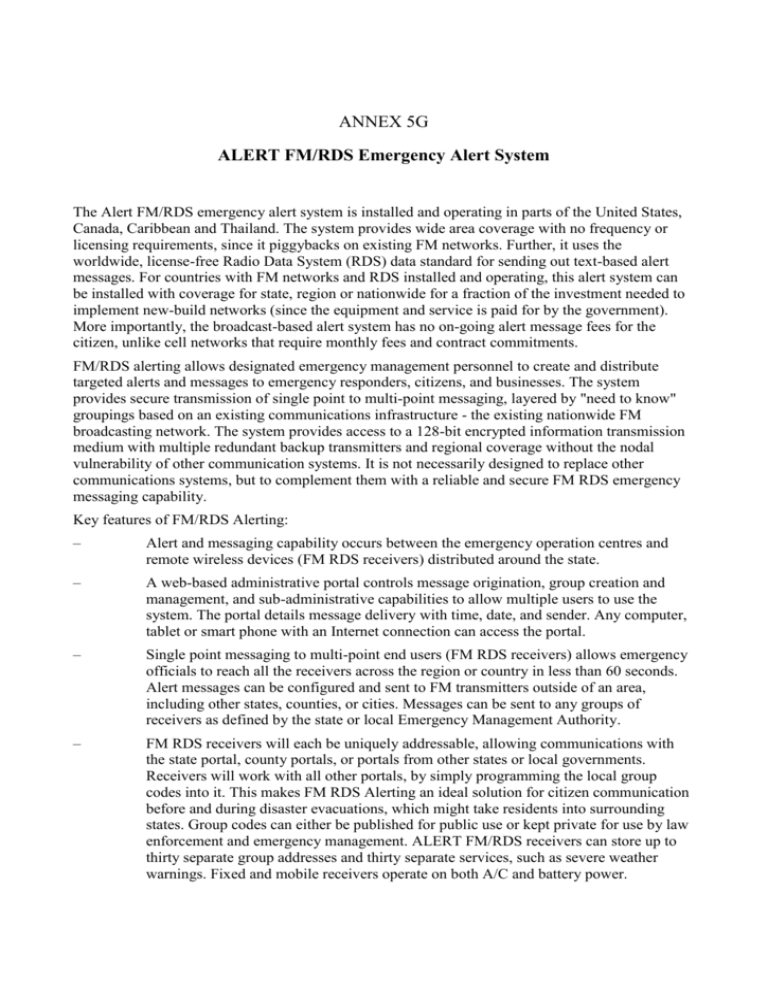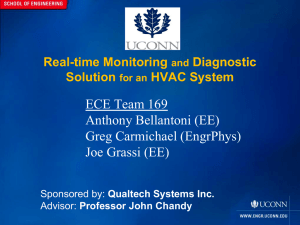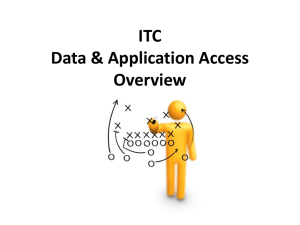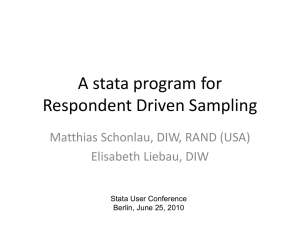Alert FM/RDS Emergency Alert System
advertisement

ANNEX 5G ALERT FM/RDS Emergency Alert System The Alert FM/RDS emergency alert system is installed and operating in parts of the United States, Canada, Caribbean and Thailand. The system provides wide area coverage with no frequency or licensing requirements, since it piggybacks on existing FM networks. Further, it uses the worldwide, license-free Radio Data System (RDS) data standard for sending out text-based alert messages. For countries with FM networks and RDS installed and operating, this alert system can be installed with coverage for state, region or nationwide for a fraction of the investment needed to implement new-build networks (since the equipment and service is paid for by the government). More importantly, the broadcast-based alert system has no on-going alert message fees for the citizen, unlike cell networks that require monthly fees and contract commitments. FM/RDS alerting allows designated emergency management personnel to create and distribute targeted alerts and messages to emergency responders, citizens, and businesses. The system provides secure transmission of single point to multi-point messaging, layered by "need to know" groupings based on an existing communications infrastructure - the existing nationwide FM broadcasting network. The system provides access to a 128-bit encrypted information transmission medium with multiple redundant backup transmitters and regional coverage without the nodal vulnerability of other communication systems. It is not necessarily designed to replace other communications systems, but to complement them with a reliable and secure FM RDS emergency messaging capability. Key features of FM/RDS Alerting: – Alert and messaging capability occurs between the emergency operation centres and remote wireless devices (FM RDS receivers) distributed around the state. – A web-based administrative portal controls message origination, group creation and management, and sub-administrative capabilities to allow multiple users to use the system. The portal details message delivery with time, date, and sender. Any computer, tablet or smart phone with an Internet connection can access the portal. – Single point messaging to multi-point end users (FM RDS receivers) allows emergency officials to reach all the receivers across the region or country in less than 60 seconds. Alert messages can be configured and sent to FM transmitters outside of an area, including other states, counties, or cities. Messages can be sent to any groups of receivers as defined by the state or local Emergency Management Authority. – FM RDS receivers will each be uniquely addressable, allowing communications with the state portal, county portals, or portals from other states or local governments. Receivers will work with all other portals, by simply programming the local group codes into it. This makes FM RDS Alerting an ideal solution for citizen communication before and during disaster evacuations, which might take residents into surrounding states. Group codes can either be published for public use or kept private for use by law enforcement and emergency management. ALERT FM/RDS receivers can store up to thirty separate group addresses and thirty separate services, such as severe weather warnings. Fixed and mobile receivers operate on both A/C and battery power. – Receivers are able to roam around the country without losing the addressability and message receipt capability. Receivers automatically tune to the strongest FM signal in their location without user intervention. The battery life of the mobile receiver is up to two months using a standard "AA" battery. – FM RDS Alerting uses equipment placed at existing FM-radio transmitters to allow messages to reach customers desired recipients. – Data from the customer administrative portals is delivered via satellite to each FM station for distribution to the receivers. This provides a secure, end-to-end data delivery system without the risk of data being delivered by terrestrial Internet to each station. – The propagation characteristics of the FM signal will provide reception for the receivers even inside buildings. – Simultaneous message reception by a targeted group of receivers occurs within sixty seconds (as defined by receiver battery charge preservation cycle) of transmission. A mode to send the message out in six seconds is available. There are no telephone network capacity issues limiting the number of calls per time frame. – Automated severe weather warnings are sent directly to FM/RDS ALERT FM receivers without action from customer portals. Citizens will benefit greatly from this proven and reliable emergency notification technology. The customer’s emergency management officials coordinate with all other emergency response agencies and act as the central command centre for alerts and messages affecting the state and counties. FM/RDS ALERT FM allows alerts and messages to flow from these emergency officials to different receivers with different access. The key to the system is that it ensures "the right people get the message" immediately and simultaneously in order to mobilise the appropriate response to whatever the alert circumstance dictates. The graphic below shows the proposed FM RDS broadcast system for a typical state or country. The system configuration includes: – Portal for message origination, user entry, and group management. This portal is hosted in professionally managed data hosting centres with redundant backup in the Southeast United States. The satellite uplink is hosted and managed by a professional service provider in the Southeast United States. Electronic security is provided for all servers through firewalls. – Existing FM radio broadcast towers from which to select primary and redundant broadcast sources. These FM broadcasters can be commercial, public, or government owned. – Receivers.






